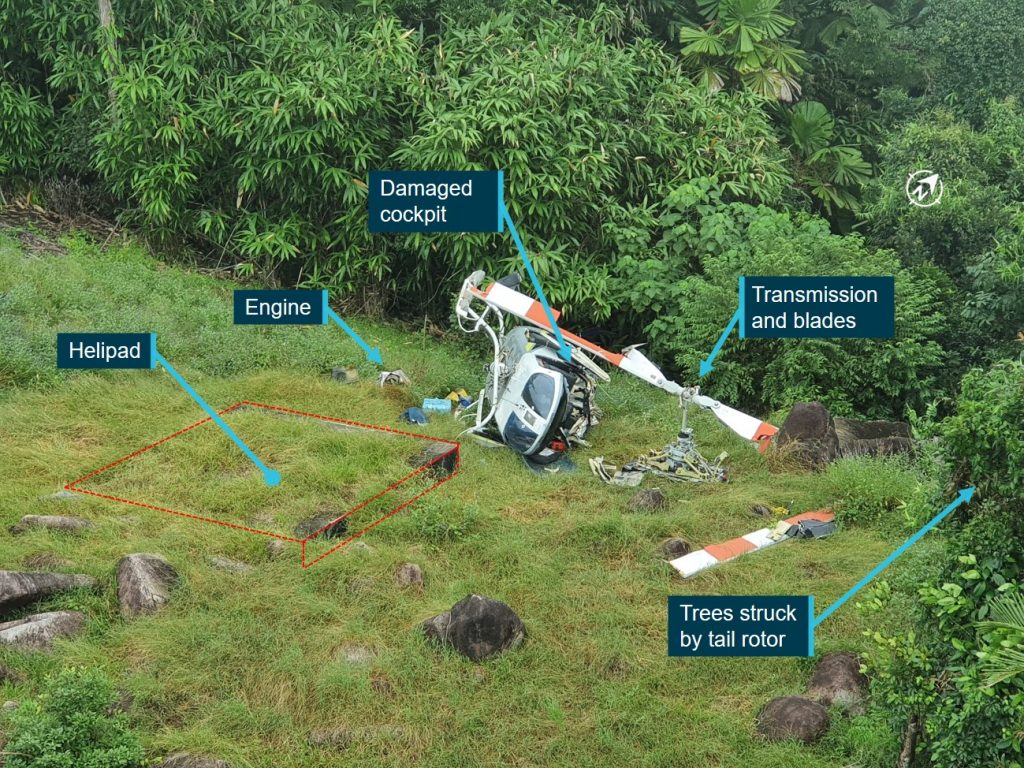 A passenger’s leg was forced out of the door of a Bell 206 and become trapped under the helicopter as it spun and rolled near a Torres Strait helipad.
A passenger’s leg was forced out of the door of a Bell 206 and become trapped under the helicopter as it spun and rolled near a Torres Strait helipad.
The revelation emerged from an ATSB investigation into the incident that saw a pilot attempt to land the LongRanger on an overgrown landing site on Moa Island in April 2020.
The tail rotor chewed up several tree branches, leading to the crash that also led the pilot to lose consciousness and the other passenger to suffer a serious hand injury.
The ATSB concluded that helipads in tropical environments must be regularly maintained to allow for rapid plant growth.
On the morning of 22 April 2020, the Bell 206L1 LongRanger, VH-NBR, operated by Nautilus Aviation was conducting a passenger charter flight from Moa Island’s Kubin Airport to Banks Peak with a pilot and two passengers on board.
Shortly after 8:00am, the pilot manoeuvred over the top of the helipad and used the helicopter’s rotor downwash to push away overgrown grass to reveal the edges of the helipad. During this process, the tail rotor contacted several tree branches of up to 45mm in thickness located on the eastern side of the helipad.
A video taken by one of the passengers recorded that as the helicopter was turning to the right, a buzzing sound was heard followed by a crack. Immediately after this sound, the helicopter spun rapidly to the right before rolling left and colliding with terrain.
The video also showed that during the accident sequence, the left rear door opened. As a result of the spinning and rolling, the rear left passenger’s legs were forced out of the door and became trapped under the helicopter, resulting in serious injuries.
The right rear passenger sustained a serious injury to one hand.
During the accident, the pilot’s helmet impacted the aircraft’s structure, resulting in a brief loss of consciousness. Paint transfer on the pilot’s helmet was of a colour matching the interior paint of the cabin. The investigation found that the use of a helmet very likely reduced the severity of the pilot’s injuries.
“The wearing of helmets is an important safety consideration when performing utility aerial work,” the ATSB’s director of transport safety, Dr Mike Walker, said.
“Survivability in the event of an accident, as was highlighted in this case, is greatly increased by wearing a helmet.”
The ATSB said the investigation also highlights the importance of the design and ongoing maintenance of helicopter landing sites (HLS) and helipads in tropical environments, and that maintenance schedules must account for rapid plant growth.
“Helicopter landing site owners are encouraged to add touchdown and positioning markings to their facilities,” Dr Walker said. “Additionally, if a landing cannot be conducted as planned, pilots should reject the landing and go-around to re-evaluate their options from a safe position away from obstacles.”
Safety action taken by Nautilus Aviation since this accident has seen its HLS template amended to include a grading system for site assessment by the chief pilot or deputy chief pilot prior to tasking pilots. Nautilus has also developed a risk assessment template for landing at non-surveyed sites, in addition to sending an alert to its pilots reinforcing the go-around procedure as stated in its operations manual.
The lessee of the helicopter landing site, the Department of Home Affairs, has also conducted a formal risk assessment of Banks Peak and other higher-risk sites throughout the Torres Strait.
The Department has stopped flying operations to landing sites deemed to have unacceptable risks until sufficient control measures have been implemented.
In addition, the Department is developing a detailed HLS brief for aircraft operators and is considering the most appropriate mechanisms for systematic engagement with other users of its landing sites.















